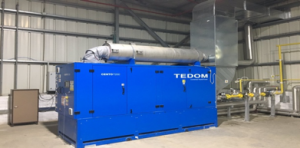Assignment 1:3 Three Definitions
Term
Cogeneration
Introduction
The three definitions assignment for ENGL 301 Technical Writing is to introduce the members of the group to a relatively complex term within your profession, and to present it as if they are not familiar with your term. This document will provide my fellow team members with a parenthetical definition, a sentence definition, and expanded definitions of my chosen term, “cogeneration”. I was introduced to this term when I began my job in the professional field of renewable energy, and I chose to share as it is an important aspect of sustainability that is helping to reduce the effects of climate change in our world right now.
Parenthetical definition
Cogeneration (simultaneous heat and power) is a form of renewable energy technology.
Sentence definition
Cogeneration, a renewable energy technology, uses a natural gas generator to produce both heat and power simultaneously. This clean technology is being implemented in shopping malls, greenhouses, farms, sawmills, hospitals, and other sites that require large amounts of energy and heat.

Source: Carbon Solutions Group Canada Agriculture Flatsheet
Expanded definitions
History of cogeneration
Cogeneration, also known as combined heat and power or CHP, is a renewable energy technology that has been introduced to Canada fairly recently by European companies like “Tedom” and “Lochinvar”. Europeans have been using this clean technology for over thirty years on farms, oil crushing facilities, greenhouses, and even in residential homes using “micro” units (Carbon Solutions Group Canada, 2019). According to Bernard Kolanowski in History of Cogeneration,although cogeneration may not have received its name until later on, “the practical use of cogeneration is as old as the generation of electricity itself” (Kolanowski, 1999, p. 74).
What makes cogeneration efficient?
Often, individuals without a lot of information regarding these generators wonder how they are actually any more efficient than other forms of electricity and heat production (coal boilers, diesel generators). Combined heat and power generators are not used as an addition or a backup to a diesel generator as one may think by glancing at the machine; they run 24 hours a day, 7 days a week, and can support an entire farm (barns, shops, houses). The reason CHP is so much more efficient is because the units recover the waste heat from the electricity generation, unlike other power sources and boilers (COGEN Europe, 2019). The use of natural gas instead of burning coal or other non-sustainable materials adds to the efficiency as well. Authors of Evaluating the role of cogeneration for carbon management in Albertastate that the use of natural gas, a “lower carbon intensive fuel”, paired with the high level of efficiency of cogeneration, make it one of the most sustainable choices in the reduction of CO2 emissions (Doluweera, Jordaan, Moore, Keith, Bergerson, 2011, p. 7973).
What are the benefits of cogeneration?
There are a few benefits that Cogeneration units possess. Firstly, the main benefit from a sustainability standpoint is the reduction of CO2 emissions that come with the installation of a CHP unit (Tedom, 2018). The units use natural gas which allows for simultaneous production of heat and power, which all help to reduce CO2 emissions. The other large benefit of combined heat and power are the savings that come with the installation of a unit. In one example case study by Carbon Solutions Group Canada, they installed a Cogeneration unit at a farm. To install the unit, it cost the farm $454,987, and within 4.69 years, the unit had paid for itself, saving the farm $96,975 a year (2018). A lot of these savings come from the fact that once a site has installed a unit, they become their own utility provider for their power, meaning that they eliminate all delivery charges that they previously paid for before purchasing a CHP unit (Carbon Solutions Group Canada, 2018).
How big are the cogeneration units and where is it usually placed?
The Cogeneration units can range from 35kw which would typically be placed in a small barn, all the way up to the largest unit, 4000kw, which would be placed in a very large utility facility of some sort (Carbon Solutions Group Canada, 2018). The size of the unit would be chosen by the CHP unit provider based on the amount of electrical output that is required for that particular client.
What does a cogeneration unit look like?
This is a photograph of a Cogeneration unit. This is one of the T200 units, which is a middle sized unit that the European company “Tedom” deploys in Canada. The photograph shows the blue box portion which contains all the wiring, and the grey tube that transports the excess heat.

Source: Tedom Cento CHP Units
https://www.tedom.com/en/CHP-units/cento
Word Document: 1.3 Amy Vergouwen Three Definitions
References
Carbon Solutions Group Canada. (2018). Combined heat & power agricultural flatsheet. Retrieved from https://csgcanada.ca/combined-heat-power/
Carbon Solutions Group Canada (2019). Combined heat & power. Retrieved from https://csgcanada.ca/combined-heat-power/
Cogen Europe. (2019). What is cogeneration? Retrieved from https://www.cogeneurope.eu/knowledge-centre/what-is-cogeneration
Doluweera, G., Jordaan, S., Moore, M., Keith, D., Bergerson, J. (2011). Evaluating the role of cogeneration for carbon management in Alberta. Energy Policy, 39:12, 7963-7974, DOI: https://doi.org/10.1016/j.enpol.2011.09.051
Kolanowski, B. (1999). History of cogeneration. Cogeneration and Competitive Power Journal, 14:1, 74-79, DOI: 10.1080/10668683.1999.10530325
Tedom. (2019). Tedom CHP Units. Retrieved from https://www.tedom.com/en/CHP-units/cento/
Leave a Reply